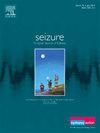中国西部地区中文版癫痫焦虑量表(EASI)及其简易量表(brEASI)的验证。
IF 2.7
3区 医学
Q2 CLINICAL NEUROLOGY
引用次数: 0
摘要
目的:翻译并验证中国癫痫患者癫痫焦虑量表(EASI)及其简易量表(brEASI)的中文版。方法:选取四川省人民医院成年门诊患者。焦虑症的类型通过Mini国际神经精神病学访谈(Mini)确定。所有患者均完成中文版广泛性焦虑障碍-7 (GAD-7)、中文版癫痫神经障碍抑郁量表(C-NDDIE)和EASI/brEASI。计算Cronbach’s α系数,分析受试者工作特征(ROC)曲线。结果:共纳入110例癫痫患者。根据MINI标准发现26例(23.6%)患者存在焦虑障碍。中国brEASI的Cronbach’s α系数为0.873。在本研究中,brEASI检测所有焦虑症的AUC为0.883,最佳临界值为bb0.7,敏感性为92.3%,特异性为72.6%。对于非广泛性焦虑症的诊断,brEASI有更高的AUC(0。886),性能优于GAD-7 (AUC = 0)。824)。结论:中文版EASI和brEASI在癫痫患者焦虑筛查中可能可靠且优于GAD-7。本文章由计算机程序翻译,如有差异,请以英文原文为准。
Validation of the Chinese version of the Epilepsy Anxiety Survey Instrument (EASI) and its brief version (brEASI) in Western China
Objective
To translate and validate the Chinese version of the Epilepsy Anxiety Survey Instrument (EASI) and its brief version (brEASI) among Chinese people with epilepsy.
Methods
Adult outpatients from Sichuan Provincial People's Hospital were recruited. The type of anxiety disorder was determined via the Mini International Neuropsychiatric Interview (MINI). All patients completed the Chinese version of the Generalized Anxiety Disorders-7 (GAD-7), the Chinese version of the Neurological Disorders Depression Inventory for Epilepsy (C-NDDIE), and the EASI/brEASI. Cronbach's α coefficient was calculated, and receiver operating characteristic (ROC) curves were analyzed.
Results
A total of 110 patients with epilepsy were included. Twenty-six (23.6 %) patients were found to have anxiety disorder according to the MINI criteria. The Cronbach's α coefficient for the Chinese brEASI was 0.873. In the study, the AUC of the brEASI for detecting all anxiety disorders was 0.883, and the optimal cutoff score was > 7, with a sensitivity of 92.3 % and a specificity of 72.6 %. For the diagnosis of non-GAD disorders, the brEASI had a greater AUC (0. 886) and performed better than the GAD-7 (AUC = 0. 824).
Conclusion
The Chinese version of the EASI and brEASI may be reliable and superior to the GAD-7 for anxiety screening in patients with epilepsy.
求助全文
通过发布文献求助,成功后即可免费获取论文全文。
去求助
来源期刊

Seizure-European Journal of Epilepsy
医学-临床神经学
CiteScore
5.60
自引率
6.70%
发文量
231
审稿时长
34 days
期刊介绍:
Seizure - European Journal of Epilepsy is an international journal owned by Epilepsy Action (the largest member led epilepsy organisation in the UK). It provides a forum for papers on all topics related to epilepsy and seizure disorders.
 求助内容:
求助内容: 应助结果提醒方式:
应助结果提醒方式:


